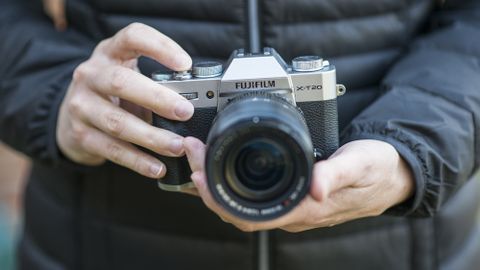Why you can trust TechRadar
Build and handling
- Magnesium top and bottom plates
- No weather-sealing
- Weighs 383g
Just as we’ve seen with the X-Pro2 and X-T2, Fujifilm has opted to tinker with and refine an existing design for the X-T20, rather than go back to the drawing board and come up with a completely new one.
As such the X-T20 takes on the slightly hunched, DSLR-style design of the X-T10, looking like an X-T2 that’s been told to lay off the chocolate biscuits.
While there’s no weather-sealing present, as on the X-T2, the X-T20 sports magnesium top and bottom plates, which along with a comfy (if modest) grip and the tactile covering used, make the X-T20 feel like a very solid and quality piece of kit – it certainly doesn’t feel like a cheap version of the X-T2.
Fujifilm's decision to stick closely to the design of the X-T10 means the X-T20 is furnished with a decent, but not overwhelming, amount of body-mounted controls. Along the top plate and to the right of the viewfinder is the large shutter speed dial, with settings running from 1 to 1/4000 sec plus Bulb, Time and Automatic.
To the right of that is an exposure compensation dial – but whereas the settings on the X-T10 ran from -2 to +2EV, the X-T20’s range has been extended to ±3EV.






As we saw on the X-T2 there's also now a ‘C’ setting on the dial, which lets you set compensation up to ±5EV using the camera's front command dial, and as on the X-T2 this works very well – we probably prefer using it this way to manually adjusting the nicely machined exposure compensation dial, as it’s easier to quickly make changes when the camera is raised to your eye.
The dedicated movie button just to the right of the shutter button on the X-T10 is now a feature on the drive dial, while there’s a programmable function button in its place. We much prefer this arrangement; with no dedicated ISO button, a quick dip into the menu to assign the function button to ISO means you can now quickly change the sensitivity.
As we’ve just touched on, there’s a dedicated drive mode on to the left of the viewfinder, which also has options for accessing the Movies, Bracketing, Advanced Filter (there are two settings for this), Multiple Exposure and Panorama modes. There are two bracketing options, one for exposure bracketing and another for Film Simulation bracketing, enabling you to produce a sequence of three images with different exposures or different Film Simulation settings.
As well as this dedicated function button on the top, there are plenty of body-mounted controls on the X-T20
Around the collar of the drive mode dial is the release for the built-in flash. We have to say that the little flash feels much less flimsy than we’ve become accustomed to on other cameras, with a decent amount of resistance when collapsing it down again.
There’s also a lever around the shutter speed dial that's designed to help less experienced photographers, enabling users to override the exposure settings of the X-T20 and set the camera to fully-automatic mode for easy point-and-shoot photography if desired.
Round the back of the camera things also look pretty familiar, with one difference: the function button that was at the bottom-right on the X-T10 has disappeared. A little disappointing perhaps, but when you consider that you’ve now got a better-placed function button on the top plate instead, it's not that great a loss.
As well as this dedicated function button on the top, there are plenty of body-mounted controls on the X-T20 – it’s possible to assign a plethora of settings to the four-way buttons on the rear, and to the AE-L and AF-L buttons too. The front and rear command dials control shutter speed and aperture, but can also be depressed to select a secondary control; however, while the rear command dial can be assigned a function when pressed, the front one is dedicated to the ‘C’ mode of the exposure compensation control.
You’ll have to use the four-way control, or tap the touchscreen to select the AF area
There’s also Fujifilm's Quick menu system, accessed via the Q button. As the name suggests this gives you quick access to 16 key settings, and it’s possible to customise these should you wish, with a choice of 28 different options. This works well, and it's handy to be able exclude features that you don't use in favor of those you do. To speed things up in the field it would have been nice to have seen the touchscreen functionality extend to the Quick menu, but that’s not an option on the X-T20 unfortunately.
While Fujifilm furnished both the X-Pro2 and X-T2 with a rather useful mini-joypad on the rear of the camera for quick AF point selection, this hasn’t made it over to the X-T20; instead you’ll have to use the four-way control, or tap the touchscreen to select the AF area.
Autofocus
- 325-point AF
- Eye-detection AF
- 5 AF-C presets
You could be forgiven for thinking that Fujifilm would give the X-T20 a stripped-down AF system compared to its flagship siblings, but that’s not the case at all, with the X-T20 featuring the same advanced system as the X-T2.
Fujifilm has made some big strides with its autofocus systems over the past year, so the upgrade in autofocus system here over the one employed on the X-T10 is a welcome change.
The hybrid AF system employs both phase-detection and contrast-detection points, with up to 169 phase-detect points arranged in a large square formation (13 x 13) in the centre, supplemented by two grids of 6 x 13 contrast-detect points either side to deliver a total of 325 focusing points across a large area of the frame – that’s up from the X-T10’s total of 49 points.
The above is for single-point AF; for Zone and Wide/Tracking this drops to a still-impressive 91-point arrangement, this time with a central grid of 7 x 7 phase-detect points, with the edges of the frame covered by two grids of 3 x 7 contrast-detect points; if you wish, you can swap to this arrangement for single-point AF if 325 points feels like overkill.

While continuous focusing with the X-T10 could at times be an optimistic affair with miss-focused shots, just as we’ve seen with the X-T2, focusing tracking with X-T20 is much improved.
Just as we saw on the X-T2, the X-T20 uses a new AF algorithm to boost accuracy, with three parameters taken into consideration. These are Tracking Sensitivity (how long the camera waits before switching focus), Speed Tracking Sensitivity (determines how sensitive the tracking system is to changes in subject speed) and Zone Area Switching (whether bias is towards the centre, auto or front).
The X-T20 features the same five presets we saw on the X-T2, with each preset using a different mix of these three parameters to suit different types of subject. The only thing that hasn’t carried across from the X-T2 is a custom setting, to enable you to tinker with the variables yourself.
Whether you’re shooting static or fast-moving subjects, the X-T20’s AF is nice and quick – we’d have little hesitation using this camera for action, especially if paired with a lens such as the XF50-140mm f/2.8 R LM OIS WR.
Current page: Build, handling and AF
Prev Page Introduction and key features Next Page Performance and image qualityPhil Hall is an experienced writer and editor having worked on some of the largest photography magazines in the UK, and now edit the photography channel of TechRadar, the UK's biggest tech website and one of the largest in the world. He has also worked on numerous commercial projects, including working with manufacturers like Nikon and Fujifilm on bespoke printed and online camera guides, as well as writing technique blogs and copy for the John Lewis Technology guide.

